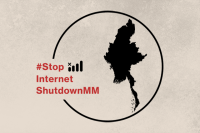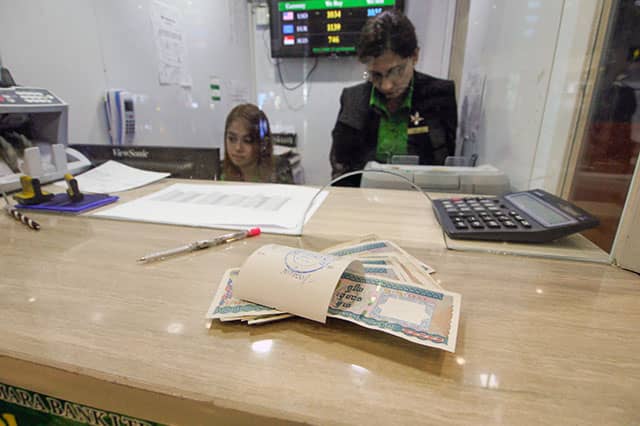What are the Causes of Air Pollution, and Consequences for Health in Myanmar, Including for Covid-19?

On 28 April, Vicky Bowman, Director of MCRB, and Matthew Baird, MCRB Honorary Research Fellow, were speakers, together with Kirt Page, at the first ever online get together by the Green Drinks Yangon Facebook group.
In the week in which Yangon had briefly topped the AirVisual/IQAir league of worst cities for air pollution on 26 April, the discussion focussed on the problems of air pollution in Yangon and wider Myanmar.
Around 20 participants dialled in from Yangon, Kalaw, Bangkok, Netherlands, Germany and beyond. They discussed the increased awareness in recent years of the harmful effects of particulates 2.5 microns or less in diameter (PM 2.5) on human health, which have been found to cause cardiovascular and respiratory disease, and cancers. Furthermore, there is growing scientific evidence from Europe and the USA of a connection between increased COVID-19 fatalities and long-term exposure to PM2.5 air pollution. In particular the ‘National study on long-term exposure to air pollution and COVID-19 in the USA’ being undertaken by Harvard University/Chan School of Public Health had analysed data from across the USA and was finding that an increase of 1 ug/m3 in long-exposure to PM2.5 is associated with an 8% increase in COVID-19 mortality.
Vicky’s presentation covered the current participatory monitoring of air pollution taking place in Myanmar and accessible via the Purple Air and Air Visual websites/apps. MCRB has had a Purple Air monitor since February 2019 which also feeds into AirVisual. She noted that even though the very first Principle of Myanmar’s 2019 National Environment Policy was ‘Every person and citizen living in Myanmar has the right to access a clean and healthy environment’, there was very little Myanmar government action taking place to date. Myanmar lacked national targets for ambient and household air pollution, key contributory factors to non-communicable disease. Despite the emerging research, neither the government nor the WHO were making any connection between COVID-19 outcomes and the importance of protecting the lungs by action to reduce air pollution at local level.
Vicky explained that powers to address all forms of pollution were given to Yangon City Development Committees and other municipalities. This included (Article 322u of the 2018 YCDC Law) the power to impose fines (30,000-100,000 kyats) and up to three month jail sentences for dumping or burning waste of any sort at places other than YCDC designated areas. However, there appeared to be low awareness of this law, and a lack of enforcement, with no data available from YCDC to suggest that they were exercising these powers. Nor was data from their three fixed air monitors established in 2015 available on the YCDC website.
Matthew’s presentation focussed on the Beijing Air Quality Approach. Over 20 years (particularly from 2013-2017, this had reduced PM2.5 concentrations by 35% in Beijing and 25% in the surrounding areas, and 90% reductions in SO2 and NO2. This reduced annual levels of 89.5 mg/m3 down to 58 mg/m3. It also reduced the number of emergency days and extreme event days when the Air Quality Index (AQI) reached dangerously high levels. The Beijing Approach involved a series of measures aimed at reducing the emission of a series of pollutants, including PM2.5, O3, NO2, CO, SO2, PM10 and improving the Air Quality Index. In addition, the Beijing City Government and the National Government developed a series of transparent warnings and approaches to extreme pollution events. This ensured that the Government built trust with the community and provided an open, transparent and accountable system to respond to air pollution emergencies. Citizens were engaged with the local and city governments to report on air pollution breaches and to act in accordance with warnings and directives.
A recent review of the Beijing Experience by the UNEP and the Beijing Municipal Government highlighted that the air quality management system is characterized by:
-
Complete legislation and enforcement mechanism;
-
Systematic planning;
-
Powerful local standards;
-
Strong monitoring capacity;
-
High public environmental awareness (UNEP 2019, p.7)
The key features of the Beijing Air Quality Approach included:
-
A long-term planning commitment to improve air quality;
-
Strong legislation on Air Quality (2000 and 2015);
-
EIA requirements to be met for any new industries;
-
Air emissions discharge permits and higher fees for emissions;
-
Installation of 1000 air monitoring stations for PM2.5 across Beijing;
-
Real-time and public access to air monitoring data;
-
Significant financial incentives to reduce emissions;
-
Halting of new-build coal-fired power plants;
-
Conversion of existing coal power plants to coal-gasification;
-
Clear Action Plan for public warnings of extreme air pollution events;
-
Closure of air polluting facilities during extreme air pollution events;
-
Prosecutions and financial penalties for breaching air quality standards.
Matthew emphasised that this had required long-term action over two decades. It needed strong legislation (made at the centre, with implementation delegated to the municipalities, who were funded with a mixture of central budget and locally raised fines), and full public awareness, understanding and participation. He noted that the causes of air pollution in Beijing (industry and coal-fired power plants, polluting cars) were different to Yangon (mainly burning garbage and biomass, including leaves and agriculture stubble, similar to elsewhere in SE Asia).
Kirt Page shared detailed data and discussed the contribution to air pollution from different sources.
The high air pollution the previous week, despite the closure of factories and lack of traffic due to COVID-19, showed that traffic and industry were not the major contributors. This was also backed up by the low measurements of ozone (which is associated with traffic pollution). He explained how the readings from the monitors connected to PurpleAir.com were corrected with an algorithm when uploaded to AirVisual, which made this data the most accurate. He noted that PM2.5 can travel long distances, and agricultural burning even 200 miles away can have an impact. He and the Air Quality Yangon team were analysing NASA satellite photos of burning for correlation with bad air days in Yangon.
A representative of youth group Air Quality Yangon highlighted their air quality monitoring activities available on www.cleanairmm.com and the awareness campaign that they had undertaken in Dec 2019/Jan 2020, supported by Save the Children’s ShiftMyanmar youth campaign. This had shown how low public awareness was of the health impacts of air pollution. Ancedotal experience of some of the group members was that even when local neighbours complained, Yangon residents continued to burn, claiming it was ‘their right’ – something which the YCDC Law clearly shows is incorrect.
Participants shared experience of working on and around the air pollution issue, and the linked question of waste management in Myanmar, India and Nepal. It was agreed it could only be addressed through multiple angles, including greater attention from health policy makers and support from development partners. It was noted that even where municipalities collected waste it was often burnt, or caught fire, or else dumped in the rivers. Thant Myanmar had started a study of which dumps were burning. Greater separation of organic waste and installation of biodigesters etc was needed. Members of Parliament should be encouraged to question the enforcement of existing laws, particularly in Yangon.
A solution would also require an end to the ‘blame game’ and commitment to individual action, such as composting leaves as an alternative to burning, on which BokashiMyanmar was active, and creating options for neighbourhoods to do so. However tackling stubble burning in favour of ‘stubble retention;’ in the soil could only be achieved if support for alternatives was provided to farmers, in addition to law enforcement, as mixed experience in India and other countries showed.
 English
English မြန်မာ
မြန်မာ မြန်မာ (unicode)
မြန်မာ (unicode)










